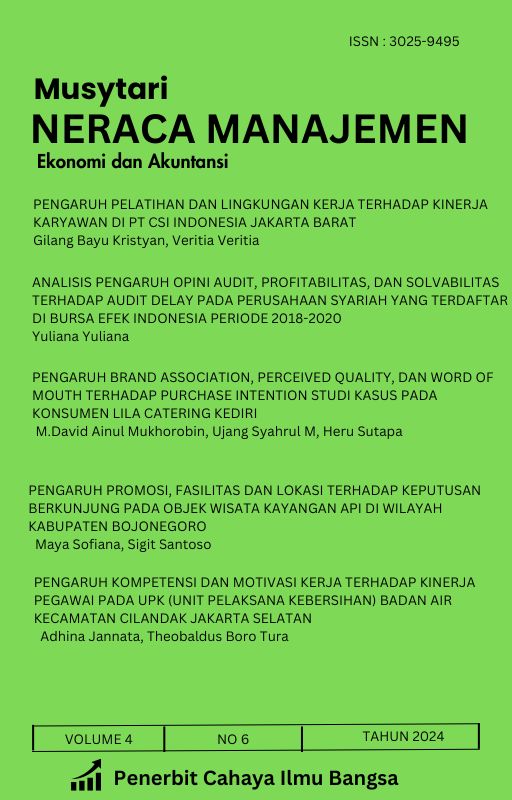PENGARUH PENGGUNAAN PAYLATER, GAYA HIDUP HEDONIS, DAN PROMOSI PENJUALAN TERHADAP IMPULSIVE BUYING BEHAVIOR PADA MAHASISWA PENGGUNA APLIKASI SHOPEE DI KOTA BANDUNG
Published 2025-06-22
Keywords
- Using of Paylater, Hedonistic Lifestyle, Sales Promotion, Impulsive Buying Behavior, Shopee
How to Cite
Abstract
This study aims to analyze the influence of Paylater usage, hedonistic lifestyle, and sales promotions on impulsive buying behavior among university students using the Shopee application in Bandung City. The background of this research is based on the phenomenon of increasing e-commerce transactions in Indonesia, particularly among students, driven by easy access to digital technology, payment services like Paylater, and aggressive promotions. Impulsive buying behavior is a concern as it may lead to financial problems, especially for students without a steady income. A quantitative method with descriptive and causal approaches was employed. Data were collected through online questionnaires distributed to 386 Shopee users among university students in Bandung. The analysis techniques used include descriptive analysis, classical assumption test, multiple linear regression analysis, hypothesis testing, and coefficient of determination with the help of SPSS software version 30. The results indicate that all three independent variables Paylater usage, hedonistic lifestyle, and sales promotions have a positive and significant effect, both partially and simultaneously, on impulsive buying behavior. Paylater usage has the strongest influence, followed by sales promotions and hedonistic lifestyle. The coefficient of determination (R²) of 0.652 shows that 65.2% of the variation in impulsive buying behavior can be explained by these three variables. The contribution of this research lies in an in-depth understanding of the factors that drive impulse buying among college students, as well as the implications for more responsible personal financial management and marketing strategies. Suggestions include Shopee should maximize paylater, associate products with a hedonic lifestyle, and design promotions that are fast and personalized, so that Shopee can maintain the trend of impulsive buying among college students. It is also important to balance the strategy with financial education so as not to cause long-term negative impacts. Future research can expand the variables by including self-control or income factors, as wall as using a qualitative approach to explore the psychological motivations behind impulse buying.
References
- [1] A. Wardhana, M. Pradana, H. Shabira, D. M. A. Buana, D. W. Nugraha, and K. Sandi, “The Influence of Consumer Behavior on Purchasing Decision Process of Tokopedia E-Commerce Customers in Indonesia,” Mar. 2021.
- [2] Goodstats.id, “E-Commerce Paling Banyak Dikunjungi Sepanjang 2023,” Goodstats. Accessed: Oct. 24, 2024. [Online]. Available: https://goodstats.id/infographic/e-commerce-paling-banyak-dikunjungi-sepanjang-2023-aVFg5
- [3] Irawati, “Top! Transaksi E-Commerce Sepanjang 2023 Tembus Rp453,75 Triliun,” infobanknews.com.
- [4] M. Miao, T. Jalees, S. Qabool, and S. I. Zaman, “The effects of personality, culture and store stimuli on impulsive buying behavior: Evidence from emerging market of Pakistan,” Asia Pacific Journal of Marketing and Logistics, vol. 32, no. 1, pp. 188–204, Jan. 2020, doi: 10.1108/APJML-09-2018-0377.
- [5] R. Salim, “Pengaruh Promosi Penjualan, Electronic Word Of Mouth Dan Hedonic Shopping Motivation Terhadap Pembelian Impulsif Pada Aplikasi Shopee (Studi Kasus Pada Mahasiswa Stei Indonesia),” STEI INDONESIA JAKARTA, Jakarta, 2020.
- [6] R. Mursalin, D. A. Pramesti, and N. Kurniati Bachtiar, “Pengaruh Promosi Penjualan, Electronic Word Of Mouth, Hedonic Shopping Motivation Terhadap Impulse Buying,” Jurnal Universitas Muhammadiyah Magelang, Jun. 2022, [Online]. Available: https://journal.unimma.ac.id
- [7] T. D. Pratiwi, “Pengaruh Penggunaan Fitur Shopee Paylater Dan Gaya Hidup Hedonisme Terhadap Perilaku Konsumtif Mahasiswa Fkip Universitas Pancasakti Tegal,” Universitas Pancasakti Tegal, Tegal, 2022.
- [8] N. E. Putri and A. Ambardi, “Pengaruh Gaya Hidup Hedonisme Dan Promo Tanggal Kembar Terhadap Impulse Buying,” Jurnal Bintang Manajemen, vol. 1, no. 3, pp. 282–294, Aug. 2023, doi: 10.55606/jubima.v1i3.1932.
- [9] P. Kotler and G. Armstrong, Principles of Marketing, Seventeenth. New York: Pearson Higher Education, 2018.
- [10] A. Amriadi et al., Pemasaran Terpadu. Padang: GET PRESS INDONESIA, 2023.
- [11] Jain Vipin, Malviya Bindoo, and Arya Satyendra, “An Overview of Electronic Commerce (e-Commerce),” Journal of Contemporary Issues in Business and Government, vol. 27, no. 3, Apr. 2021, doi: 10.47750/cibg.2021.27.03.090.
- [12] B. Prasetiyo, “Kepuasan Konsumen Di Industri Suvenir Dalam Perspektif E-Commerce Dan Kualitas Layanan,” Jurnal Manajemen Industri dan Logistik, vol. 5, no. 1, pp. 10–18, Feb. 2021, doi: 10.30988/jmil.v5i1.467.
- [13] Y. Pratika, S. Salahudin, D. W. U. Riyanto, and T. Ambarwati, “Analysis of Pay Later Payment System on Online Shopping in Indonesia,” Journal of Economics, Business, & Accountancy Ventura, vol. 23, no. 3, pp. 329–339, Mar. 2021, doi: 10.14414/jebav.v23i3.2343.
- [14] I. E. Prastiwi and T. N. Fitria, “Konsep Paylater Online Shopping dalam Pandangan Ekonomi Islam,” Jurnal Ilmiah Ekonomi Islam, vol. 7, no. 1, p. 425, Mar. 2021, doi: 10.29040/jiei.v7i1.1458.
- [15] F. T. I. A. Saleh et al., “SEIKO : Journal of Management & Business Pengaruh Penggunaan Shopee Paylater Terhadap Pembelian Impulsif Pada Mahasiswa,” SEIKO : Journal of Management & Business, vol. 6, no. 1, 2023, doi: 10.37531/sejaman.v6i1.4165.
- [16] A. H. M. P. Putri and A. D. Khoiryasdien, “Hubungan antara gaya hidup hedonis dengan perilaku konsumtif pembelian skincare wajah pada mahasiswi di Yogyakarta di tinjau dari tingkat pendapatan,” Yogyakarta, Sep. 2024.
- [17] P. Kotler and K. L. Keller, Marketing Management, 15th ed. Pearson Education Limited, 2016.
- [18] R. F. Baumeister, “Reflections and Reviews Yielding to Temptation: Self-Control Failure, Impulsive Purchasing, and Consumer Behavior,” JOURNAL OF CONSUMER RESEARCH, Inc. •, vol. 28, 2002.
- [19] B. Verplanken and A. Herabadi, “Individual differences in impulse buying tendency: Feeling and no thinking,” Eur J Pers, vol. 15, no. 1 SUPPL., 2001, doi: 10.1002/per.423.
- [20] Sugiyono, Metode Penelitian Manajemen. Yogyakarta: Alfabeta, 2022.
- [21] A. Wardhana and M. Pradana, “Service Quality And Brand Reputation As Antecedents Of Brand Choice: The Case Of Ride-Hailing Applications In Southeast Asia,” Journal of Eastern European and Central Asian Research, vol. 10, no. 3, pp. 387–400, 2023, doi: 10.15549/jeecar.v10i3.1033.

